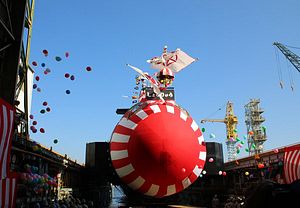Japanese shipbuilder Kawasaki Heavy Industries (KHI) launched the 10th Soryu-class diesel-electric attack submarine (SSK) in Kobe on November 6, according to a KHI press release. The new SSK was laid down in January 2015 and is expected to enter service with the Japan Maritime Self-Defense Force (JMSDF) in 2019.
The new sub, which has been named Shuriyu, is the fifth Soryu-class boat to be built by KHI and the 28th submarine overall constructed by the shipbuilder after the end of World War II. The remaining submarines of the Soryu-class were built by Mitsubishi Heavy Industries (MHI), which has assembled 26 subs since the end of the war.
The 4,200-ton (submerged) Soryu-class boats are the JMSDF’s first SSKs to be fitted with air-independent propulsions (AIP) systems, enabling the submarines to stay underwater for up to two weeks. Japan plans to build a total of 12 Soryu-class SSKs. In 2015, Japan’s Ministry of Defense (MoD) announced that it intends to equip the last two boats of the class with lithium-ion batteries. (According to some reports, the other boats of the class will be retrofitted with the batteries as well.)
Soryu-class SSKs are powered by two Kawasaki 12V 25/25 SB-type diesel engines and four Kawasaki Kockums V4-275R Stirling AIP engines for silent running. The boats have an estimated range of 6,100 nautical miles (11,297 kilometers) with a maximum surface speed of 13 knots and a subsurface travelling speed of 20 knots. The maximum diving depth of the sub is around 650 meters.
The Soryu-class is fitted with six HU-606 533 mm torpedo tubes that can accommodate Type 89 heavyweight homing torpedoes and UGM-84 Harpoon anti-ship missiles. Next to bow-and-flank-mounted Hughes/Oki ZQQ-7 sonar arrays, the sub is also equipped with a towed array sonar capable of detecting ships over 70 kilometers away.
The Soryu-class’ hull is made of high tensile steel covered with anechoic coating to reduce both the SSK’s sonar signature and sounds emanating from inside the boat. As I explained last year, Soryu-class subs boast increased maneuverability:
The Soryu-class boats’ hydrodynamic design is based on the older Oyashio-class diesel-electric attack submarines currently in service with the JMSDF. It is (…) fitted with a computer-controlled, Swedish-designed X rudder to increase the submarine’s maneuverability when operating in shallow waters close to the seabed.
The boats reportedly especially excel in executing small turns over topographically complicated sea floors, which is not only a testimony to Japanese engineers’ technology savvy but also to the high level of training of JMSDF submariners. Given the Soryu-class’s high degree of automation, the crew is also smaller than on previous JMSDF subs and consists of nine officers and 56 sailors.

































